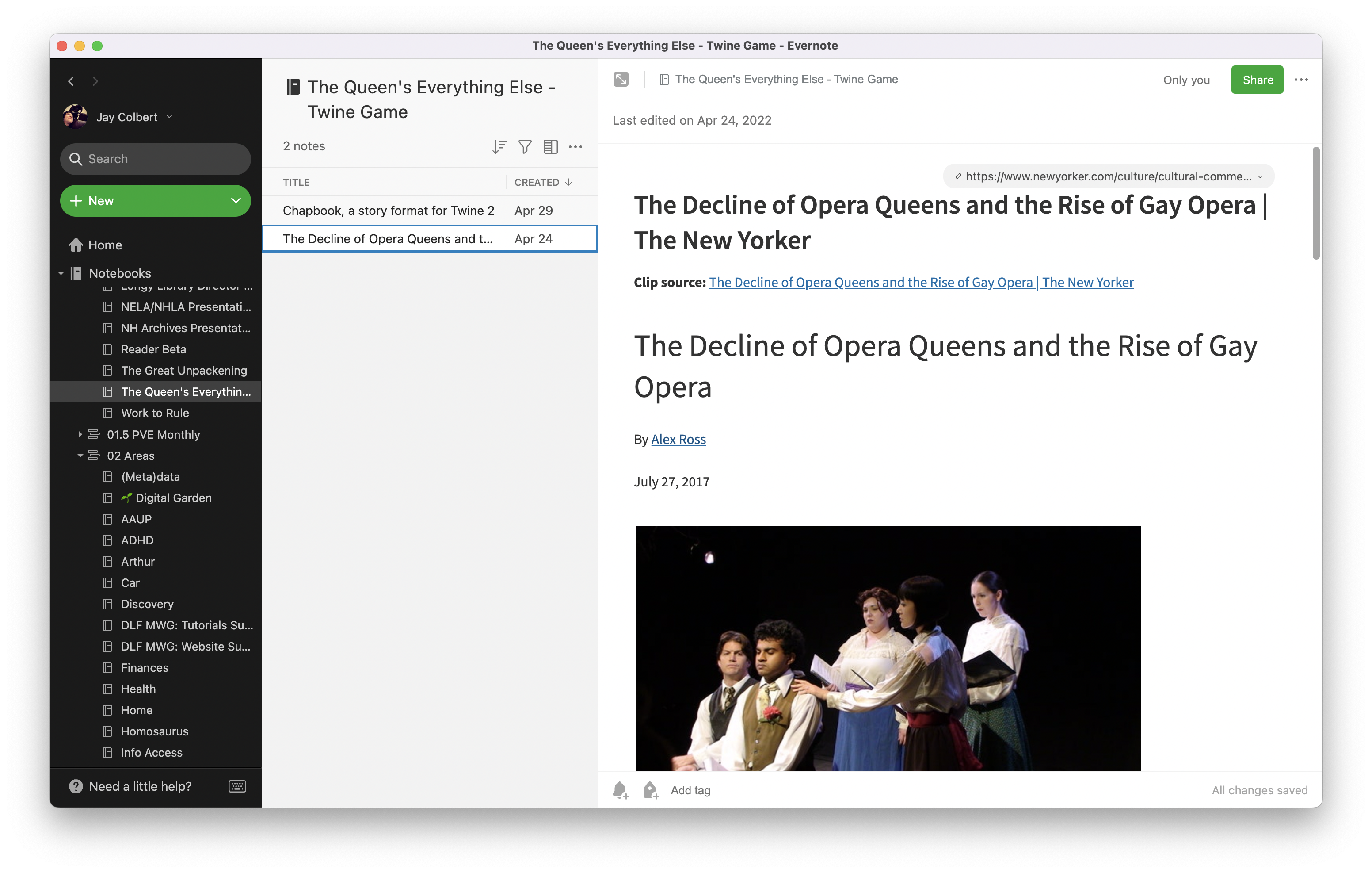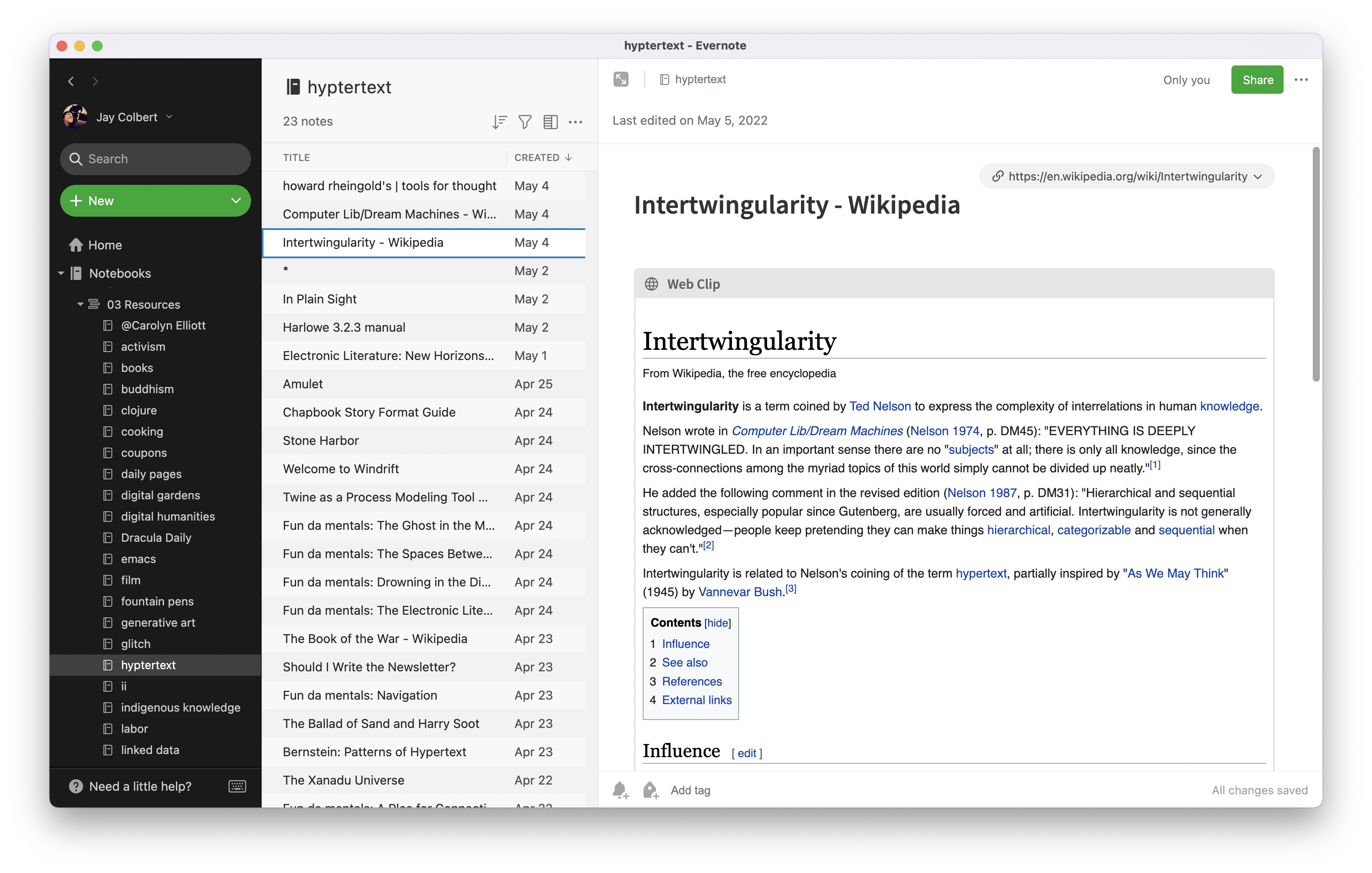Every time I search a note-taking tool online, I inevitably see it: “Using insert-tool-here to build my second brain” or some variation on that theme. The video or blog post will always go over the basics of what a second brain is, and it usually mentions that the person took Tiago Forte’s Building a Second Brain course.
So I guess it’s my turn.
What is Building a Second Brain
Building a Second Brain is a methodology, online course, and (as of writing this post) forthcoming book by Tiago Forte. It’s a framework for personal knowledge management which helps to relieve information overload, build connections between our notes, and helps us express our ideas. I’m not gonna go into the whole structure and method here; you can read Tiago’s many posts about it.
On the surface level, the system seems focused on Capital P Productivity to help you create Capital C Content so you can market it and make money and be an entrepreneur and CEO and on and on and on. However, I noticed something surprising during the course: the mentors whose sessions I attended, many of my fellow students, and even Tiago kept emphasizing pleasure, joy, sensual experience in the body, resonance — all these things I absolutely did not expect. Sure, there was a healthy contingent of people focused on marketing and making money and whatnot. Fine, good for them. But otherwise, this course I took because I’m an ADHD mess and also a nerd for intertextuality and knowledge organization turned out to be about much more than that.
Instead of just being about how to Capture information, Organize it, Distill it, and Express it (remember, for Content you can Monetize), Building a Second Brain was about changing how I relate to information. Hell, it was about how I even define what information is. My mentors all stressed that the express part of the process includes how we live our lives, how we relate to the people around us, how we honor ourselves. One of the very first things I learned was not just how to capture information, but how to tell if it resonates with me, how that feels in my body. I’m already interested in the [[erotics of metadata]] and the [[aesthetics of information]], this was perfect!
Why I’m Interested
I’ve always been a person who loves seeing how texts connect. A lot of the movies, music, and literature I love are because I would read or watch or listen to something in high school, look up whatever movie or band or book it mentioned, rinse repeat. In college, the kinds of connections I would make and insights I would have when writing my English papers were…odd, to be kind about it. And then I became a metadata librarian, where I figure out how to connect and organize information for a living so other people can find it and use it.1
You would assume, then, that I would be amazing at managing all the knowledge and information I interact with. Ha, you’re very funny. I’ve tried a bunch of things over the years. In 2019, I encountered Tiago’s PARA organization system. I tried setting it up, but I didn’t really stick with it. But starting there, I eventually went down a bunch of rabbit holes and learned about Zettelkasten and digital gardens and Roam Research and networked thought and wow, it blew my mind. I am not always great at using folder hierarchies, and I’m also not great at tagging. Connecting ideas while writing, linking directly to a title, makes so much more sense to me.
As a metadata librarian, I’m interested in how the Building a Second Brain framework views information, how we relate to information, and how information relates to other information. I’m so excited to see how I might bring in some of what I learned to library metadata, even though that is moving the micro to the macro.
How I Build My Second Brain
Alright enough chit chat.
I want to preface this by saying:
- As of writing, my system is barely a month old
- It is messy, imperfect, and always subject to change as my needs change
- What works for me absolutely will not work for you because no two second brains will look alike. However, I hope seeing how I do it is useful!
Tools
Capture
I capture information in four ways, depending on what the information is and why I’m capturing it. More often than not, I’m using one of Evernote’s various clippers, either for websites, email, or on my phone. It’s just so easy. Evernote sucks with Tweets though, so I usually capture those with Readwise or Logseq. I try to capture web articles2 and newsletters with Readwise, and Readwise also captures any Kindle highlights I take.3 I like to embed more visual tweets in Logseq, especially if they’re something I might want to reference in my digital garden. Most of my “fleeting notes”4 are taken in Logseq and then distilled later. Finally, I carry around a tiny notebook small enough to fit in my front jeans pocket, and I have a tiny fountain pen to match. I love fountain pens, and I love how tiny the notebook is. This makes it fun to write, and so I like using these tools.
Organize
I use the PARA5 system anywhere I have notes of any kind. I even use it in my task manager. Mostly, things live in Evernote. It’s like a big filing cabinet, and I like it for keeping project notes all together. I didn’t think I would like it as much as I do (remember, I hate folders and tags), but because I’m not trying to link thoughts together, I like it just fine.


Distill
Tiago has his whole Progressive Summarization method of distilling. Basically, it’s taking the important (to you!) bits of the information you’re returning to and pulling them out, making them noticeable, so you can skim and use what you really need later. And this is all great and good, but you have to remember that you don’t have to do it all the time. You just do it when you need to do it, and not every note is going to require the same degree of it.
My digital garden and Zettelkasten are a form of distilling, and a cycle of divergence and convergence. Ideas start small, so I diverge and let them grow wild. Then, I converge and distill them to a polished Zettel.
Distill can also be practiced via daily/weekly/monthly/annual reviews, where you distill your feelings and experiences.
Express
Express is when you put everything together and create something new. I also like the framework of express referring to how we live our lives and relate to other people.
Right now, my primary mode of expression would be this website, I suppose. My expression also includes any scholarly work I do, the conversations I have with my friends, the peace I feel knowing everything I might need to take care of my beloved cat is just one folder away, organizing with my fellow workers, the way I touch and move my body, and so much more.6
I hope this was useful and even mildly interesting to anyone who isn’t me or from the whole #pkm scene.
If you’re someone like me who loves knowledge management but also thinks most things to do with marketing and entrepreneurship and tech bros are embarrassing at best and ethically indefensible at worst, I would say give it a shot. I’m having a lot more fun with it than I expected, and it was worth every penny.
I wonder how many other librarians have taken the course. ↩︎
I capture academic sources with Zotero. Apparently people are willing to pay money to have me coach them on Zotero now? If you would also like to pay me money for such a service, email me at jay l colbert at gmail dot com. ↩︎
Readwise can capture a whole bunch of information sources. I’m kind of obsessed with it. ↩︎
Projects, Areas, Resources, Archives. Although, I have issues with the use of Archives, so I use Attic instead. ↩︎
Lots of discussion in my cohort on queering our second brains and of using them as anti-capitalist tools. ↩︎